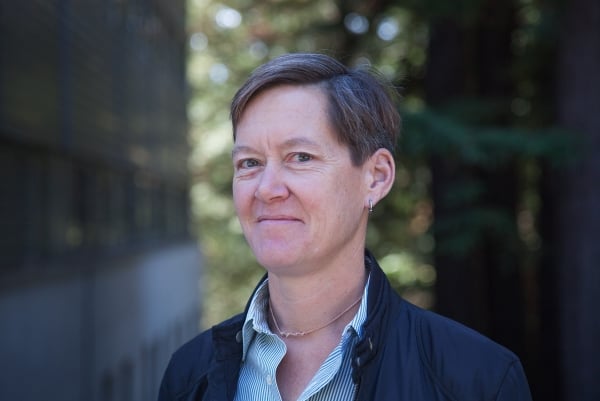You have /5 articles left.
Sign up for a free account or log in.

Jody Green serves as the associate campus provost for academic success, supporting intelligent course design and faculty professional development.
University of California, Santa Cruz
Faculty members are responsible for a student’s academic experience, but as student success has grown as a national priority for higher education practitioners, the faculty’s role in the conversation is being left behind or misguided, at least according to one rising administrator.

University of California, Santa Cruz
Jody Greene of the University of California, Santa Cruz, started as the university’s first associate campus provost for academic success in July, though they’ve been developing this role for the past 18 months. Greene is passionate about supporting early-career faculty members and improving student outcomes with intentional and equitable course design and hopes to address both ideas in their first year.
Greene spoke with Inside Higher Ed about the role of faculty success, their philosophy for student success and how similar institutions can prioritize student success and research.
Q: What led you to a career in higher education?
A: That’s a difficult question for me. I think I always knew that I would teach, and as I moved up through the educational system, I kept thinking that I would teach whatever level that I was at. But when I realized that, as a professor, you had the opportunity to have multiple lives within one life. I think that really appealed to me. What I didn’t realize is that my life’s work would be trying to figure out how we do a better job of balancing those different lives.
Q: What does that mean, to balance different lives?
A: At prominent public research universities, we have this new movement around student success, but it really has not been thought of in terms of what is the impact of that focus on the faculty role. So what it means to balance them is not to have an additive model of student success, where you leave all the faculty’s existing duties the same, and then you add this priority called student success on top—you actually have to step back and rethink how to balance the faculty role in order not to break the faculty.
Q: In student success, often those leading the conversations are those in front-line staff or administrative positions, not faculty members. Where do you see the faculty in the student success infrastructure of a university?
A: Faculty have authority over courses and curriculum, and so the piece of student success that really hasn’t caught up to the student-facing side is the part that involves the redesign of our courses and curricula.
You could have all the best support systems in place for students, but if our courses and curriculum don’t work for students—students can’t succeed if we’re redesigning courses and not making sure that that benefits students in their downstream coursework. Those are the places where the faculty needs to be involved, because student-facing support stuff can’t affect courses and curricula, and similarly, faculty members can’t become student support systems.
So what we need to do in, in my view, is to ask everybody in the institution to think about what is within their sphere of influence. As faculty members, how we design courses, how we design curriculum and programs, and how we mentor are the primary areas in which we affect students. We can also provide research opportunities and experiential learning, but really, I don’t think we’re going to be successful at student success until we address the core of students’ academic programs.
Q: What is your new position, and what does your purview entail?
A: My new position is the associate campus provost for academic success. My provost, Lori Kletzer, uses this phrase, “academic success,” to describe the place where faculty success, student success and institutional priorities meet. It forces us not to think of students’ success independent of how the student success movement affects faculty success. To me, it’s really about crafting a sustainable institutional approach to student success that doesn’t leave out the faculty, that centrally includes the faculty, that leverages their expertise and respects the complexity of their workload and working life.
Q: How do you define faculty success?
A: There’s a big piece of it that has to do with early-career faculty development—making sure that there’s teaching support for your new faculty, making sure that they’re paired with an instructional designer so that we don’t have to redesign the courses that they designed on their own when they arrived.
That’s one of the things that we’re really focused on right now. If early-career faculty can be given a foundation in equitable teaching practices and paired with support professionals who can help them design and deliver their courses, well, that’s going to make a huge difference.
I think a lot of the conversation about the faculty role in student success has focused on teaching practices and faculty demeanor. Those things are important, but it’s critical that our courses be designed well. And a well-designed course that is taught by someone who’s still developing in their teaching is going to yield more learning than a poorly designed course taught by someone with a lot of experience.
A lot of [faculty success] has to do with early-career faculty success; it has to do with helping early-career faculty and mentoring them so that they can get started with their research while also being supported to develop as teachers. It has to do with looking hard at your academic personnel practices and asking yourselves whether— for us as a double minority-serving institution [Hispanic-serving institution and Asian American, Native American, Pacific Islander–serving institution]—do our personnel practices reflect the institutional values that are going to drive the demands made of faculty members?
Because right now, a lot of academic personnel in higher ed, especially at research universities, is misaligned with what the university says it wants out of the faculty. What it’s actually assessing them on is really not in direct communication, and that’s going to get us in trouble; it’s going to lead to retention troubles.
It’s also particularly important at institutions like mine that have made significant efforts to diversify their faculty, because we know that the student success efforts fall most heavily on faculty members of color. We can’t basically penalize the faculty members of color and make them carry the weight of the students, of the institution’s equity goals, thereby undermining our faculty-facing equity goals.
Q: What are your goals for your first year?
A: I really want to hear from early-career folk about what kind of support they’re interested in. I’ve spent seven years building early career faculty resources, but in order to have really comprehensive early-career faculty development, I feel like I need to be in conversation with the early-career faculty. You can’t just throw out a workshop every other week and expect them to show up, even if what you have to offer is really urgent and important stuff. That is not how you build effective faculty support.
So I want to partner with the new faculty in that part of my job to create really useful programming for them, some of which just includes finding each other in a university that is physically, and otherwise, very decentralized.
The other part is to be in conversation—this is the other half [of the] job, that’s not the faculty development part—is to be talking with my colleagues in departments about their departmental curriculum and about course redesign and bringing the resources to them that they need to engage in those sorts of design challenges. I don’t believe that we will improve in the areas that we want to improve without a design focus. So convincing my colleagues that redesign is the part of the student success challenge that is in our sphere of influence, that’s really critical to my first year.
Q: Why is there a need to get buy-in related to course design?
A: I think partly because the conversation, both on our campus and in the higher ed press, is so much focused on, still, who’s a good teacher or who’s a bad teacher. And this isn’t really about good teachers and bad teachers. It’s about good design and poor design. I don’t think it’s that it’s hard to sell people on it; I think it’s that we’ve never been asked to think about design. As faculty members, we’ve never been asked to think about instructional design or course design; we put our courses together in a kind of intuitive way—I certainly did throughout my own teaching career.
My campus has invested admirable resources in bringing course design support to the faculty, and I want to make sure that people know about that and also that we figure out how to make sure that they have the time to engage in that redesign.
Q: What advice would you give to peers or colleagues working in academic success?
A: I think that my advice is for is for the highest levels of institutional leadership, that if you have decided that student success is a priority for your campus, you need to have a faculty administrator whose job it is to try to figure out how to make that a sustainable proposition for your faculty.
There is a kind of magical thinking in the student success movement sometimes, that if we just say that student success is a priority, and we leave everything else unchanged in our institutions, that [we] will be successful. And I don’t think we will.
I think you have to engage the faculty, involve the faculty and make sure that they are given the resources that they need to shift their attention away from the kind of hyperfocus on research that it’s had. I think we can still have outstanding research universities, but if we also want the faculty to be very engaged in student success, we have to equip them for that. We cannot just expect them to “do better,” as people say, because they don’t have the skills, they don’t have the resources, they don’t have the training, they don’t have the background to do that. I think the best way that we can do it is start professional development earlier in graduate school and in the early part of the career.
My advice is, give somebody the job of balancing faculty success and student success. That to me is the missing piece right now in the student success movement. I don’t hear people talking about how it relates to faculty success, and I think any kind of zero-sum plan is going to really hurt the institution as a whole later on.
My institution’s No. 1 goal is student success, and its No. 2 goal is research excellence. Those have to be thought [of] together, especially from the perspective of the faculty, otherwise, it’s a totally unsustainable proposition.
Get more content like this directly to your inbox every weekday morning. Subscribe here.
This article has been updated to correct the spelling of Jody Greene's name




